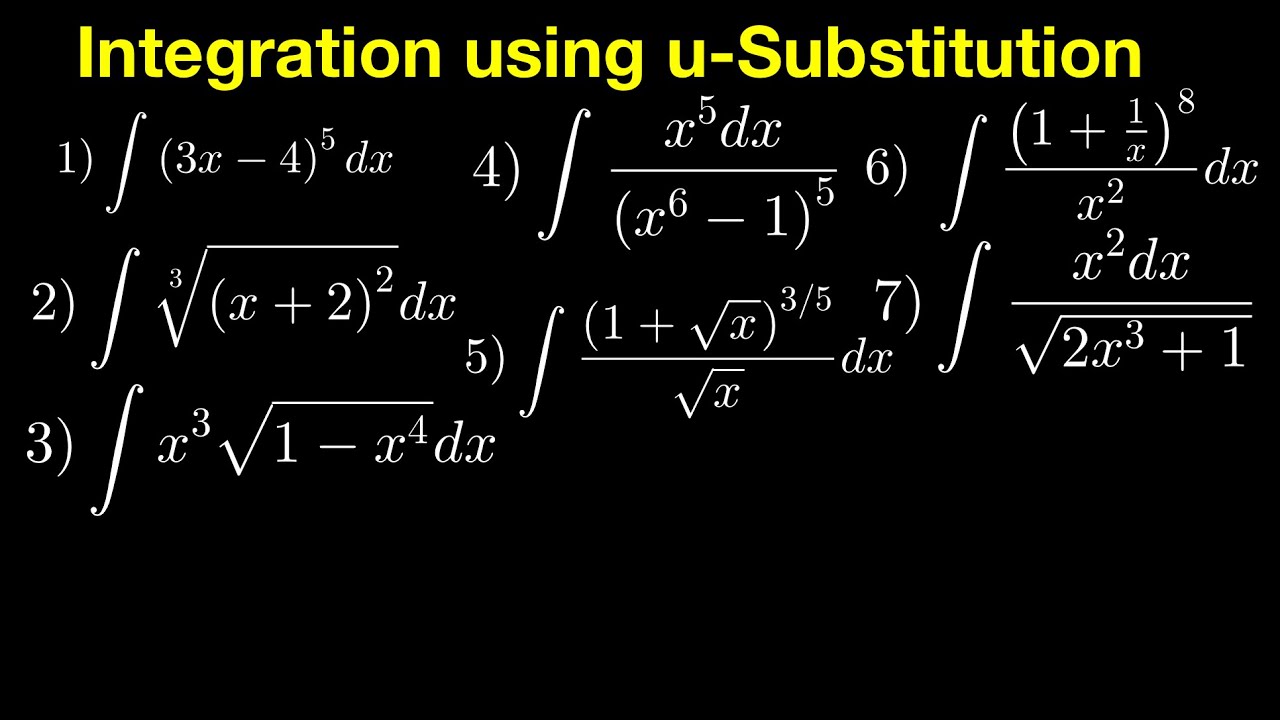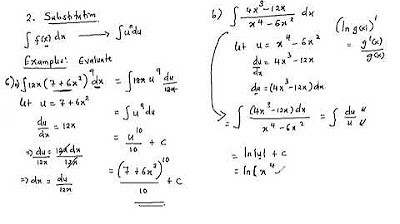Changing the Order of Integration (Double Integrals)
TLDRThis video tutorial delves into the concept of changing the order of integration for double integrals, a technique crucial for solving complex integrals that are difficult to evaluate in their given order. The instructor provides step-by-step examples, illustrating how to reassign bounds and transform the integral into a more manageable form. The video covers various functions, including exponentials and trigonometric expressions, demonstrating the use of u-substitution to simplify the integration process. By the end, viewers are equipped with the skills to tackle challenging integrals by strategically altering the order of integration.
Takeaways
- 📚 The video discusses changing the order of integration for double integrals, which is useful when the original order makes the integral difficult or impossible to solve by hand.
- 🔄 The process involves rewriting the integral with the other variable's differential first (e.g., from ∫dxdy to ∫dydx) and adjusting the bounds of integration accordingly.
- 📈 The first example involves integrating an exponential function, e^(-x^2), which is not straightforward in the original order but becomes manageable after changing the order of integration.
- 📐 The script explains how to visualize the region of integration in the plane and determine the new bounds for the integral based on the shape of the region.
- 🧩 The second example shows how to integrate sine(y^2) by changing the order of integration to dxdy, which simplifies the process and allows for a more straightforward solution.
- 📉 The third example deals with the integral of the square root of (x^3 + 1), demonstrating that changing the order of integration can make a seemingly complex integral more approachable.
- 🔢 The script provides step-by-step instructions for setting up the new integral, including how to rewrite the bounds and how to apply u-substitution to simplify the integration process.
- 📝 The importance of correctly identifying the region of integration and its boundaries is emphasized, as this is crucial for determining the correct order and bounds for the new integral.
- 📚 The video also mentions that changing the order of integration is not always beneficial and may sometimes result in a similarly complex integral.
- 📉 The final takeaway is that the method demonstrated can be applied to various integrals to potentially simplify the integration process, offering a practical approach to solving complex problems in calculus.
- 👋 The video concludes with an invitation to viewers to join future videos, indicating a series of educational content on the topic.
Q & A
What is the main topic discussed in the video script?
-The main topic discussed in the video script is changing the order of integration in double integrals to make them easier to solve.
Why might one need to change the order of integration?
-One might need to change the order of integration when the given order makes the integral extremely difficult or even impossible to solve using known elementary functions.
What is the first example given in the script involving an exponential function?
-The first example given is an integral involving the function e to the negative x squared, which is difficult to integrate with respect to x first, so the order is changed to integrate dy dx.
How does the script suggest rewriting the bounds when changing the order of integration?
-The script suggests rewriting the bounds by looking at the shape of the region in the plane and assigning new bounds that correspond to the new order of integration.
What substitution is used in the script to simplify the integral involving e to the negative x squared?
-The script uses a u-substitution where u is equal to the exponent, negative x squared, and du is negative 2x dx, to simplify the integral.
What is the second example in the script, and what function is involved?
-The second example involves integrating sine y squared with respect to y, which is difficult to do by hand, so the order is changed to integrate dx dy.
How does the script describe the region of integration for the sine y squared example?
-The region of integration is described as the first quadrant of the xy-plane, bounded by y equals x and y equals pi, with x ranging from 0 to pi.
What substitution is suggested for the integral involving square root of x cubed plus 1?
-The script suggests a u-substitution where u is the inside of the root, x cubed plus one, and du is three x squared dx, simplifying the integral.
What is the final example in the script, and how is the order of integration changed?
-The final example is an integral involving the function square root of x cubed plus 1, and the order of integration is changed to dy dx to make it easier to solve.
How does the script explain the process of changing the order of integration for the square root of x cubed plus 1 example?
-The script explains by first identifying the region of integration, then fixing an x value and drawing through in the y direction to determine the new bounds for the integral.
Outlines
📚 Introduction to Changing Order of Integration
This paragraph introduces the concept of changing the order of integration in calculus, which is essential when the given order makes the integral difficult or impossible to solve using basic functions. The instructor sets the stage for the topic by mentioning previous videos on double integrals and then jumps into the first example, which involves an exponential function that can't be integrated with respect to x first. The region of integration is visualized as a triangle with vertices at (0,0), (2,0), and (0,2), and the new order of integration is dy dx, with the bounds rewritten accordingly. The paragraph concludes with the setup for the new integral and the first step of the integration process.
🔍 Integrating Exponential Function with Changed Order
The second paragraph delves into the process of integrating an exponential function with the new order of integration dy dx. The instructor explains how the exponential function becomes a constant when integrated with respect to y first, simplifying the process. The integration is then carried out step by step, using u-substitution to transform the integral into a solvable form. The bounds for the new integral are identified, and the final expression for the integral is presented, showcasing how changing the order of integration can make a complex problem more manageable.
📉 Changing Order for Sine Function Integration
In this paragraph, the focus shifts to integrating the sine of a squared variable, which is not straightforward with the original order of integration. The instructor outlines the region of integration in the first quadrant of the xy-plane and determines the new order of integration to be dx dy. The region is visualized as a triangle above the line y=x and below the line y=π. The integration process begins by setting up the new integral with the correct bounds and proceeds to integrate with respect to x, treating the sine function as a constant. The paragraph concludes with the setup for u-substitution to simplify the integral further.
🔄 Final Examples of Order Changing for Integration
The final paragraph presents additional examples of changing the order of integration to simplify the process. The first example involves integrating a function involving the square root of a cubic term, which is more manageable when the order is changed to dy dx. The region of integration is identified as the area below a parabola defined by y=x^2 and above the x-axis, with bounds from x=0 to x=2. The integration is set up with the new bounds, and a u-substitution is suggested to simplify the integral. The second example involves a similar approach, with the integral being transformed to a more solvable form by changing the order and applying u-substitution. The paragraph concludes with a summary of the benefits of changing the order of integration and a sign-off for future videos.
Mindmap
Keywords
💡Double Integrals
💡Order of Integration
💡Region in the Plane
💡Exponential Function
💡Trigonometric Function
💡U-Substitution
💡Antiderivative
💡Bounds
💡Elementary Functions
💡Integration by Parts
Highlights
Introduction to changing the order of integration for double integrals when the initial order is difficult to integrate by hand.
Explanation of how to change the order of integration by looking at the region in the plane and assigning new bounds.
Demonstration of changing the order of integration for an exponential function that is difficult to integrate with respect to X first.
Rewriting bounds and changing the order of integration to integrate dy DX for the exponential function.
Visualizing the region of integration and determining the new bounds for the double integral.
Integration of the exponential function by first integrating with respect to y, simplifying the problem.
Use of u-substitution to simplify the integral after changing the order of integration.
Changing the order of integration for a sine function squared, which is difficult to integrate directly.
Rewriting the bounds for the sine function squared and changing the order to integrate DX dy.
Integration of the sine function squared by first integrating with respect to x, simplifying the integral.
Application of u-substitution to the integral of the sine function squared after changing the order.
Changing the order of integration for a function involving the square root of x cubed plus 1, which is challenging to integrate directly.
Rewriting the bounds and changing the order to integrate dy/dx for the square root function.
Integration of the square root function by first integrating with respect to y, which simplifies the process.
Use of a u-substitution technique to further simplify the integral after changing the order of integration.
Final evaluation of the integral using the new bounds and the u-substitution method.
Transcripts
5.0 / 5 (0 votes)
Thanks for rating:





